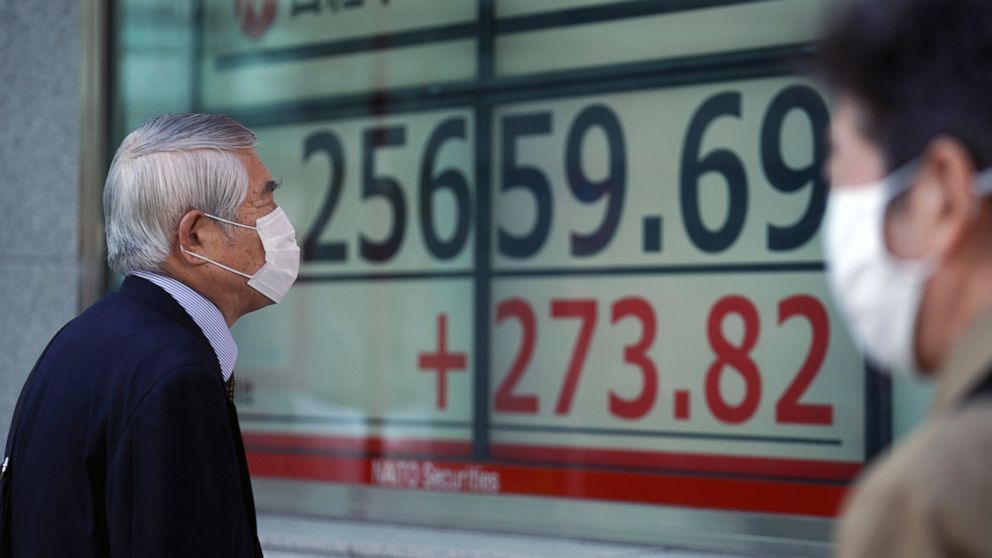S&P 500 adds to record, Dow heads for own on vaccine hopes
NEW YORK — Stocks are rallying again Monday, with the S&P 500 adding more to its record high and the Dow Jones Industrial Average on track to erase the last of its pandemic losses, following another round of encouraging data on a possible coronavirus vaccine.
Moderna said early in the morning that its COVID-19 vaccine appears to be 94.5% effective, according to preliminary data. It’s the second time this month that a company unveiled such encouraging numbers about a vaccine, boosting hopes that the global economy can return to some semblance of normal next year.
Leading the way again for markets were stocks of companies whose profits would benefit the most from the economy climbing out of its deep recession, such as travel companies and banks. At the same time, investors’ interest continued to dim for tech companies and other stocks that dominated the stay-at-home economy created by the pandemic.
The S&P 500 was 0.9% higher in afternoon trading and adding to its all-time high set on Friday. The Dow Jones Industrial Average was up 383 points, or 1.3%, at 29,863, as of 12:42 p.m. Eastern time, and on pace to surpass its record of 29,551.42 set in February before panic about the pandemic sent stocks tumbling. The Nasdaq composite was 0.5% higher, lagging the rest of the market amid lessened interest for tech stocks.
Treasury yields, oil prices and stocks around the world also rallied on the shot of increased optimism. A vaccine is precisely what markets have been waiting for to pull the global economy out of its cavern, and analysts say it’s a game changer.
Of course, for all its euphoria, many risks remain for the market. It’s still not guaranteed when a vaccine could be widely available, let alone whether one ultimately will. The pandemic is continuing to worsen, meanwhile, with rising coronavirus counts across the United States and Europe pushing governments to bring back varying degrees of restrictions on businesses.
“The vaccine could help people breathe a sigh of relief, but the devil is in the details,” said Gene Goldman, chief investment officer at Cetera Financial Group, referring to the need for more complete data and a eventual distribution plans.
But investors for now are focusing on the possibility of a world next year where customers are again going outside to work at offices, buying things at enclosed stores and heading on vacations. Cruise operator Carnival jumped 10.5% for one of the biggest gains in the S&P 500, though it’s still down 65% for the year so far. Energy and industrial companies had the strongest gains among the 11 sectors that make up the index.
The latest vaccine news “increases the likelihood that we will eventually return back to normal,” Goldman said. But, investors will need to see more improvement from the services sector of the economy in order to gain more confidence in the recovery.
Moderna climbed 7.9% amid the widespread rally. Mall owner Simon Property Group rose 7.3% after it negotiated down the price for its takeover of rival Taubman Centers, and PNC Financial Services Group rose 2.2 after it agreed to buy the U.S. subsidiary of Spain’s BBVA bank.
Stocks of smaller companies rose more than the rest of the market, another signal of rising expectations for the U.S. economy. The Russell 2000 index of small-cap stocks gained 2%.
Some of the strongest companies throughout the pandemic were lagging, including a 0.5% dip for Amazon. Other winners of the stay-at-home economy struggled more. Zoom Video Communications fell 3.5%, Peloton sank 1.1% and Netflix slipped 0.6%.
Dr. Stephen Hoge, Moderna’s president said that having similar effectiveness results from two different potential vaccines is reassuring. While approval for the vaccine can come within weeks, the rollout of the drug will take more time.
Even before the vaccine news, markets had been trading higher as investors welcomed the signing on Sunday of an agreement establishing the world’s biggest trade bloc, a group of 15 countries that includes China, Japan, South Korea, 10 countries in Southeast Asia, New Zealand and Australia. The United States, the No. 1 economy, is not a part of it.
Called the Regional Comprehensive Economic Partnership, the pact mostly will bring already low tariffs lower over a 20-year period. It is expected to have a positive but incremental impact on trade in the region.
“The fact that the agreement got over the line after eight years of negotiation between a widely disparate group of nations is an achievement in itself,” Jeffrey Halley of Oanda said in a commentary. “That has left the Asia-Pacific with a feeling that there is life in the world, with or without the United States.”
Meanwhile, data released Monday showed Japan, the world’s third largest economy, grew at a 21% annual pace in the last quarter, the first quarter of growth in nearly a year.
Japan’s Nikkei 225 rose 2.1%, South Korea’s Kospi gained 2% and Hong Kong’s Hang Seng added 0.9%. Stocks in Shanghai climbed 1.1%.
In Europe, France’s CAC 40 jumped 1.7%, and Germany’s DAX returned 0.5%. The FTSE 100 in London gained 1.7%.
Benchmark U.S. crude oil climbed 3% to $41.35 per barrel amid hopes that a healthier economy would burn more fuel. Brent crude, the international standard, rose 2.8% to $43.97 per barrel.
The yield on the 10-year Treasury rose to 0.90% from 0.87% late Friday.
———
AP Business Writers Elaine Kurtenbach, Joe McDonald and Yuri Kageyama contributed.
![]()


